Chess Notation: The Complete Guide
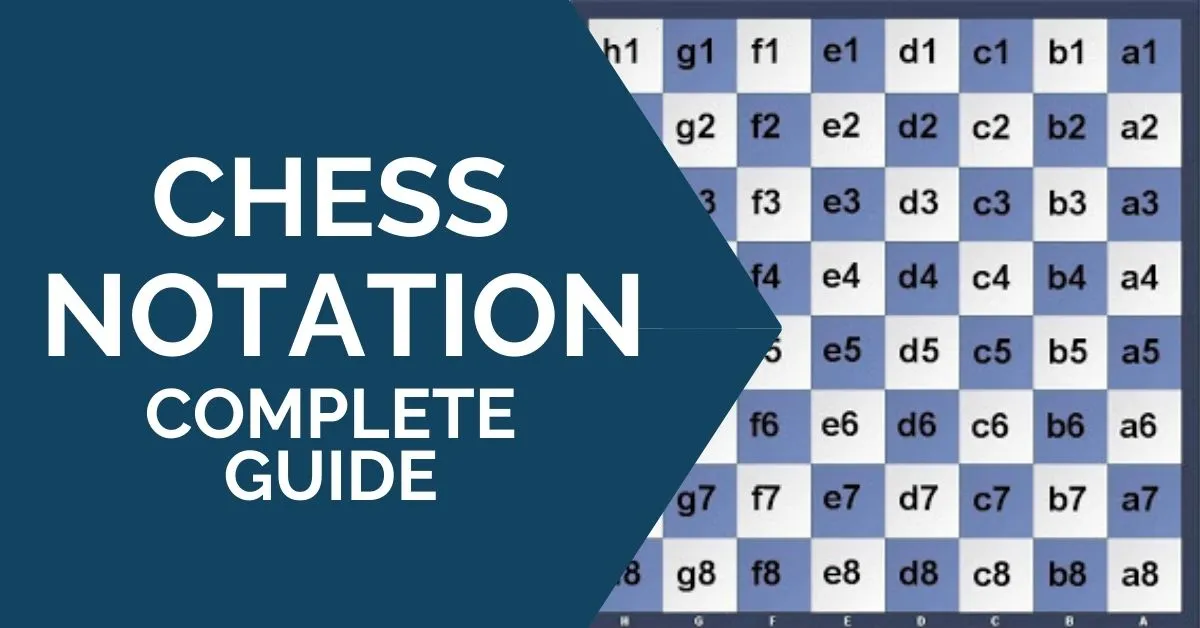
Chess notation is the language of chess and you will eventually need to learn it if you want to continue down this road and make your journey easier. One of the first things you learn when starting out is how to read each square. Each of the 64 squares has a unique name and you will hear strong players and Grandmasters naming them constantly when they analyze. It might be confusing at first and it might take a while before you can quickly identify a square, but you will get there, with a little patience.
Why do you need to learn Chess Notation?
There are a number of reasons why you should learn chess notation and the first that comes to mind is so that you can keep studying and learning!
You can find games that are analyzed by Grandmasters in books, magazines, or different chess blogs. In order to be able to understand what’s going on and replay the game, you will need to learn how to “translate” the notation into chess moves.
Secondly, if you want to take part in a tournament you will need to write your moves down. It is not negotiable; writing the moves on your scoresheet is mandatory in chess competitions!
The Scoresheet
One of the main reasons why this is necessary is that the scoresheet is proof of how the game went and how a player reached the position on the board. You can make claims to the arbiter based on the moves you’ve written down (for example, three-fold repetition or the 50 moves rule draw). The arbiter will then come to your board, check both score sheets and decide whether the claim is correct or not.
Apart from the technical reasons, writing down your moves during a game is very useful for your own improvement. One of the main tools of self-improvement is analyzing your own games and learning from your mistakes. Most chess players will have a database of their own games that they will analyze and annotate. Our own games are full of instructive moments and identifying a pattern of mistakes or the moments in which we tend to make mistakes shows us what we need to be focusing on in future training sessions.
Moreover, if you are part of a chess group, it is a lot more fun to be able to take part in the conversations about chess than watching passively without understanding what the rest is talking about. Most chess players are able to discuss games and positions without needing an actual chessboard in front of them and if you don’t know how to read the chessboard, you will most likely be only a spectator.
The good news is, chess notation is very easy to learn and you can master it only in a few hours!
How chess notation works
You can write down each move by combining the name of the piece with the name of the square it lands on. You start with the piece, then comes the square.
Each square has a name and it is very important you learn to identify them fast in order to make the learning process easier. With time, you will be able to visualize each square even without a board in front of you and name every one of them without thinking. To name a square you will first read the letter (the file it is on) and then the number of the corresponding rank.
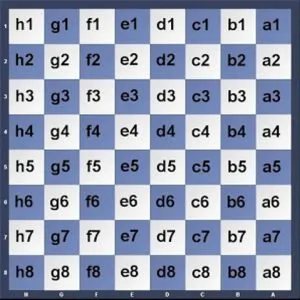
Notation for piece moves
When writing down a move, each piece is represented by a symbol. Traditionally, for example, when you write your moves during a game, you will use a letter for each piece.
The letters are easy to remember, as they will be the first letter of the piece (except for the knight, as you will see below). The pawn is the only one that isn’t represented by any capitalized letter; you simply write the square it moves to.
However, in chess books and magazines you might find a different, computer symbol. They are easy to recognize, as they imitate the real chess pieces. Here are the abbreviations and symbols for each chess piece:
King – K
Queen – Q
Rook – R
Bishop – B
Knight – N
Pawn – no abbreviation when writing the move
Chess notation for special moves
In chess, there is also a category of special moves. Here we have the castle (both sides), as well as the en-passant. Next, we will talk about how we write these moves down. We will also see other symbols, used to highlight checks, checkmate, and captures, for example.
Chess notation for ‘Check’
We don’t announce checks during a game in chess. But, you can write the symbol down if you’d like. You will also find it in books in magazines, as the computer will automatically add it at the end of a move if that move puts the opponent’s king in check. The symbol for this situation is a “+”. For example, if you’d move your rook to e1 and put the black king in check, then this would be represented as Re1+.
En Passant
You can write down the en-passant move as any other pawn versus pawn capture. You write the letter of the file your pawn starts on and then the name of the square it ends on. Let’s take the following situation:
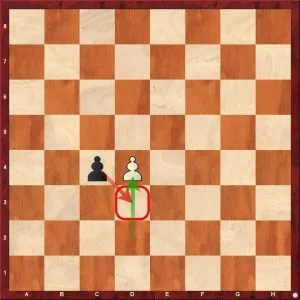
Let’s assume that the white pawn has just advanced to d4, passing by the black c4 pawn. At this point, black could capture the white Pawn en-passant. After this move, the black pawn would end up on d3, so we would write the move down as cxd3 (pawn from the c file takes and ends up on d3).
Chess notation for Castling
Castling is one of the most important special moves in chess. It helps put the king into safety and quickly develop one of the rooks, at the same time. There are two castling options and here’s how you write them down:
1- 0 for short (kingside) castle. It is easy to remember, as there are two squares in between the king and the rook for kingside castling
0-0-0 for a long (queenside) castle, where there are three squares in between the king and the rook.
Checkmate
The checkmate also has its symbol and it comes right after the move that gives a checkmate. It can be a #, a ≠ , or ++. Here’s an example:
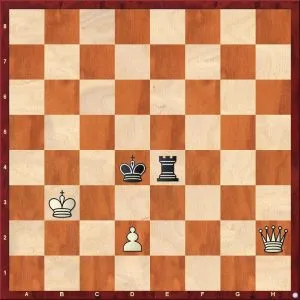
Here, you would write the move that delivers checkmate as 1.Qd6#
Chess notation for move quality
In some books, magazines, or annotated games you will find different symbols next to the moves. These are meant to highlight the quality of the move – e.g. if the move was a good or a bad one. These are the different symbols you can find after a move:
! good move
!! very good (brilliant) move
? bad move
?? very bad/ terrible move (blunder – a move that loses or can lose the game)
!? interesting move
?! dubious move
What does +- stand for in this topic?
Lastly, some symbols are there to show the evaluation of a position. You will usually find these at the end of a line when the annotator analyses a sequence of moves that players didn’t play in the game. The most commonly used symbols:
= equal position
+/= or ⩲ slight advantage for white
=/+ or ⩱ slight advantage for black
+/− or ± clear advantage for white
−/+ or ∓ clear advantage for black
+- decisive advantage for white
-+ decisive advantage for black
∞ complicated position
=/∞ compensation
What does ‘x’ stand for?
You can highlight captures in chess, although it is not mandatory. During a game, some players choose to do so, some will just omit the symbol for the capture.
You will, however, find those in chess books, magazines, and other annotated games.
You can show it either as an “x” or “:”.
What is descriptive chess notation?
The descriptive notation is an old system that was used in English, Spanish, and French literature up until the 1980s. In 1981, the International Chess Federation stopped recognizing this notation and the algebraic notation became the main one since it is much simpler to read, write and understand.
How different is the old chess notation?
The difference between the two notations is huge.
In this article, we have been using algebraic notation – the symbol or abbreviation of the chess piece followed by the square it goes to. There is also a longer version of it, where you write both the square it leaves from and the one it gets to. For example, you can write bringing the queen from d1 to e2 either as Qe2 (short notation) or Qd1-e2 (long notation).
In the descriptive notation, the pieces are also abbreviated to the first letter of their pane, with the exception of the knight:
King = K
Queen = Q
Rook = R
Bishop = B
Knight = N or Kt
Pawn = P
But the main difference is the way the squares the pieces go to are described – the files get their name from the piece that occupies the first rank at the start of the game. For example, the “d” file will be “Q” in the descriptive notation (Queen’s file). Since we have two bishops, two knights, and two rooks, it will be necessary to distinguish between the two sides of the board. This is done in relation to the queenside and kingside.
So, the “h” file would be “KR” – kingside rook’s file and the “b” file “QN” – queenside knight’s file. The ranks are also considered in a different way. In the algebraic chess notation, the first rank is always the one closest to the white player and the 8th the one closest to the player with the black pieces. In the descriptive chess notation, the ranks are always considered in relation to the player who’s making the move. This means that you would write the move “e5” in the old notation as P-K4 (pawn to king’s 4).
Algebraic vs. Descriptive Notation
Here’s an example of how the first moves of the Ruy Lopez Opening would look like in algebraic vs. descriptive notation:
e4 – e5 1. P-K4 P-K4
Nf3 – Nc6 2. NKB3 (knight to King’s Bishop 3) – NQB3 (knight to Queen’s Bishop 3)
Bb5 – a6 3. BQN5 (bishop to Queen’s Knight 5) – P-QR3 (pawn to Queen’s Rook 3)
Ba4 – Nf6 4. BQR4 (bishop to Queen’s Rook 4) – NKB3 (knight to King’s Bishop 3)
Looking for more openings? Here are posts on Total Chess: Opening Systems – Part 1 and Total Chess: Opening Systems – Part 2.
Formatting chess notation into PGN
PGN stands for Portable Game Notation and it is a standard plain text format for recording chess games (both the moves and related data), which humans can read. And, most chess software also supports it.
Nowadays, most chess software allows you to copy a game and then paste it on another chess platform or even another software. If the game is annotated, then this action will copy everything – the data about the game and all the annotations inside the game (words and moves).
The related data (event, name of the players, place, year, etc) are written in between [ ].
The moves are then shown in the algebraic notation shown here, while the annotations will appear in between { }.
Chess notation into a FEN?
The FEN (Forsyth–Edwards Notation) is used to describe a certain position on the board. This won’t show all the moves of the game, as the PGN does, but only a certain position.
Again, it is very useful if you want to add a certain position to a chess platform without having to set the board manually. Most software, as well as most chess platforms, will have a “Show/ Copy FEN” option which will allow you to paste it wherever you need it.
This is an example of what the starting position looks like translated into FEN:
rnbqkbnr/pppppppp/8/8/8/8/PPPPPPPP/RNBQKBNR w KQkq – 0 1
We also recommend reviewing How to Work on Your Chess: The 5 Step Method.




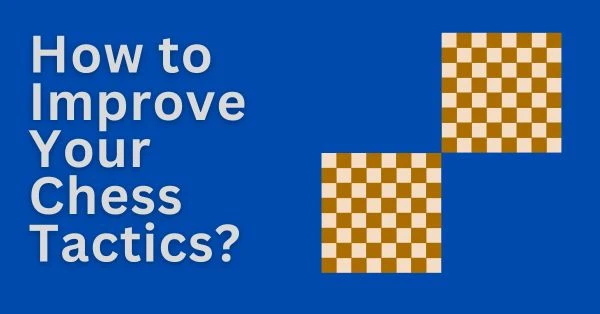
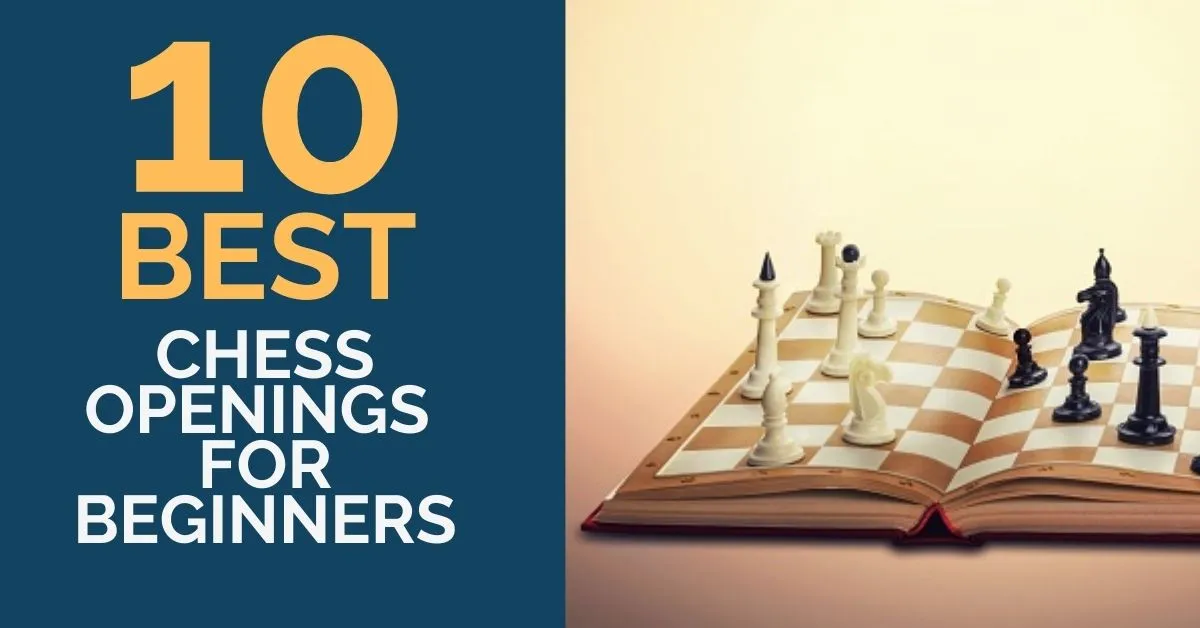




Comments: